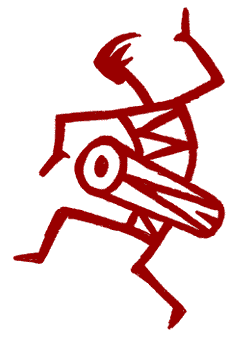

Thought of the Week Archives |
 |

|
|
|
July 14, 2003 Inner Conflict - Part 3: Identifying Your Subpersonalities When children can't get their needs met by being themselves, they will attempt to adjust who they are. By acting in different ways, they can develop mask-like personalities that will carry on into adulthood. In contrast, an emotionally healthy person does not have a "personality" protecting their real self, they just are who they are. Unfortunately, most of us had to create one main personality and a host of other subpersonalities. These characters were useful in order to survive our neurotic families, but now that we are adults, their existence can cause a host of problems in our relationships and careers. Most people don't use the word "subpersonalities" but are very aware of the moods, eccentricities, acts, or special "ways" of our family members, friends, and co-workers. How many times have you said or heard statements such as:
"I hate it when he acts like such a know-it-all!" Sometimes we will consciously put on an act to meet a certain situation, but most of the time we are unaware of the false selves we have created. Subpersonalities literally become "second nature." They rise and fall in response to various stresses and triggers in our lives. Unfortunately, "second nature" is just another phrase for "unconscious." That which remains unconscious will continue to affect our lives in unpredictable ways. Healing is about awareness, feeling, and integration, and the first step is recognition. In the case of subpersonalities, recognition often begins with the process of identifying your different false selves. Although this may be intimidating and unnerving, it will help you understand aspects of your behaviour that have remained a mystery. It is often easier to recognize the subpersonalities in others first. When we can do that, our own will become more obvious. To assist in this matter, I have compiled a list of subpersonalities offered by some colleagues of mine. You may find parts of yourself here!
Even though the variations are limitless, you may notice from this list certain commonalities that appear in slightly different ways. Since children have common needs, and dysfunctional families have common forms, we often share similar subpersonality types. If you are interested in identifying your subpersonalities, start by writing down names for your different moods, acts, or behaviours. It may be useful to do the exercise with supportive, non-critical friend or family member, since you may see subpersonalities in each other that are difficult to notice individually. When you are finished your list, you may have as few as the "classic triangle" (the inner parent, the adult, and the inner child) or you may have more than ten! If you have a large number, look to see if there are any parts that are linked in some way and may actually be variations of one subpersonality. For instance, "Mr. Know-it-all" may be linked with "The Saint" and actually be "Mr. Good and Right." If your list seems complete, look to see if there are opposing pairs, such as:
The Devil - The Saint The existence of these types of pairs will indicate certain dynamics that may operate in your life like a swinging pendulum. They are often the main characters in situations of inner conflict. Once you recognize your subpersonalities, the next step is to observe them in action. You may notice situations that trigger their appearance, and discover what their purpose is. If you enter your observations in a daily journal, you may find that they relate to events and situations in your childhood. It is often helpful to remember that all subpersonalities, no matter how troublesome, arise out of a genuine need. Subpersonalities are an attempt to protect, get needs met, and make life better. They helped us survive and need to be respected - even if they have overstayed their welcome. The Royal "We" takes on a deeper meaning! |